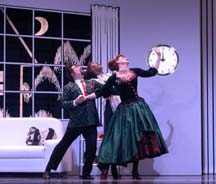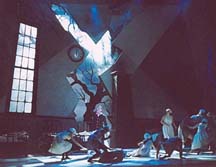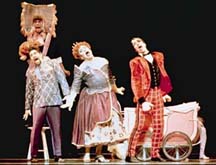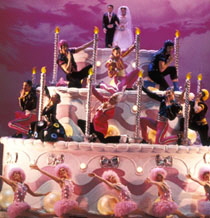|
Every December brings a flurry of Nutcrackers with Tchaikovsky's music to the San Francisco Bay Area, from the classical ballet (created by Marius Petipa/ Ivanov in Russia, in 1892) to dance-along Nutcrackers and any sort of childish or ironic versions of the theme. After the Ballets Russes introduced the Nutcracker to the West, the first American full-length version premiered in San Francisco, danced by the San Francisco Ballet and choreographed by William Christensen, in 1944. This production (revised several times since then) was seen by Balanchine who created his own Nutcracker in 1954. Picking up on the original theme of the ballet--Christmas, a little girl and a special toy --, the Nutcracker holiday tradition was born.
In the San Francisco/ Bay area, every new version has to stand up to the most original, outrageously funny re-invention, The Hard Nut, by Mark Morris.  Morris created it in 1991 for TV's Dance in America (available in a shortened version on video). Five years later he opened it at Cal Performances in Berkeley with the Berkeley Symphony Orchestra. The Hard Nut is one of the Bay Area's most cherished Christmas treats, with Cal Performances director Robert Cole regularly taking the baton. 2004 marks a break in this tradition: while Morris performs his Hard Nut for the first time in London (with orchestra, children's choir and Robert Cole), England's most famous, hugely successful modern-day Nutcracker has been imported to Berkeley for its American premiere (with canned music). Morris created it in 1991 for TV's Dance in America (available in a shortened version on video). Five years later he opened it at Cal Performances in Berkeley with the Berkeley Symphony Orchestra. The Hard Nut is one of the Bay Area's most cherished Christmas treats, with Cal Performances director Robert Cole regularly taking the baton. 2004 marks a break in this tradition: while Morris performs his Hard Nut for the first time in London (with orchestra, children's choir and Robert Cole), England's most famous, hugely successful modern-day Nutcracker has been imported to Berkeley for its American premiere (with canned music).
Matthew Bourne's Nutcracker! (with an exclamation mark) is just one year  younger than The Hard Nut. Created in 1992, it was reviewed and restaged two years ago. Both choreographers are gay. When Bourne was still dancing he created the most sexy character of the show for himself, the dope-smoking snake-like seducer "Knickerbocker Glory", while Mark Morris used the same Arabian Dance in Act II for a stint as a Harem's wife. younger than The Hard Nut. Created in 1992, it was reviewed and restaged two years ago. Both choreographers are gay. When Bourne was still dancing he created the most sexy character of the show for himself, the dope-smoking snake-like seducer "Knickerbocker Glory", while Mark Morris used the same Arabian Dance in Act II for a stint as a Harem's wife.
THE STORY
I had seen the provocative, cross-gender Hard Nut with its homoerotic touches and men dancing several roles of women, even on point shoes, several years in a row. I had seen one of Matthew Bourne's works many times, his extraordinary homoerotic Swan Lake, and been enthralled by his exclusively male swans. Would his Nutcracker! be as daring, as irreverent and amusing as The Hard Nut? Undoubtedly, the Zellerbach stage in Berkeley was set for a duel of choreographic wits.
Classical dance's most popular ballet is based on a scurrilous story by a key figure of German romanticism, E.T.A. Hoffman (whose story "The Sandman" led to Freud's famous essay on castration anxiety, "The Uncanny"). Hoffman's "The Nutcracker and the Mouse King" might also have provided fodder for Freud. The tale's explicit purpose is explaining to children why there is the phrase, "this is a hard nut to crack", and why nutcrackers are so ugly.
At the center of the German story, on Christmas Eve, little rich girl Clara is told a fairy tale by her godfather Droßelmeier. An ugly clockmaker with magical powers, he tells her "The Tale of the Hard Nut": A princess is turned into a monster by the queen of mice. A clockmaker (whose name happens to be Droßelmeier) in the toy-making town of Nuremberg knows how to save the princess: he must find the hardest nut on earth which a certain young man has to crack with his teeth in order to restore the beauty of the princess and become her royal husband. At the end of his travels, the toymaker finds the nut in his hometown and the young man turns out to be his nephew. Young, handsome Droßelmeier cracks the nut and saves the princess, but in the last minute he steps on the mouse and, alas, turns into an ugly nutcracker.
Clara, whose Christmas present from her godfather happens to be a nutcracker, dreams the happy ending of the story: the nutcracker kills the mouse king with her help, leads her to a fairyland of toys and sweets, and is transformed back into a handsome lad by her love. When Clara awakens from her dreams, she realizes that her godfather's real-life nephew, young Droßelmeier, is indeed his much better-looking alter ego.
THE DANCE
The original ballet by Petipa/Ivanov follows the story in Act I, but leaves out the curse and the nut. It also leaves out the dark underbelly of sexual awakening, fear of the ugliness and aggression of sex and its transformation through romance. In Act II, the Nutcracker, turned into a prince, leads Clara to the Land of Snow where snowflakes dance, and to the candy-inhabited Land of Sweets where the Sugar Plum Fairy presents them with a celebration of dances (The Spanish, Arabian, Russian, Chinese, Mirliton Dance and the Waltz of Flowers). The Fairy dances a final grand pas de deux with her Cavalier, before Clara awakens again with her nutcracker doll under the Christmas tree.
Both Mark Morris and Matthew Bourne were well aware of the problem with Act II which traditionally is a heavy ham of dance divertissements devoid of any emotional context and only barely tied to Clara's story. In order to put an end to this puritanical and superficial avoidance, Morris turns Act II into a coming of age love story between the girl and the Nutcracker, with oedipal undertones as his Nutcracker is Uncle Drosselmeyer´s replica, dressed alike in checkered pants and a red jacket, with the same black pomaded hairdo. Bourne creates a somber Christmas of poor orphans and a coming of age story tinged with rivalry and jealousy.
In Morris´ The Hard Nut, the Christmas party takes place in the 70´s, at a tacky, nouveau-riche home of a comically dysfunctional family. The set, all in stylish black and white, comes right out of Charles Burns´ pop cartoons, complete with a kitschy plastic tree and the yule log burning on the TV.  The mother dominates the party with the sentimental hysterics of a plump, old-school "queen" (superbly danced, on the video and every year on stage, by Peter Wing Healey), but is undone by her three fighting kids, Marie (i.e. Clara), brother Fritz (perfectly impersonated by a female), and a sex-crazed teenage sister. The Nanny is another brilliant transvestite, a saucy black bean-stalk of a dancer on point shoes (Kraig Patterson, video and stage). The party guests are a stoned, boozy and raunchy bunch, giddily launching into Tchaikovsky's music to do the Bump. One of them is Morris himself in a comical bit as an alcoholic who is after the Nanny and almost falls prey to the unleashed teenage daughter. Drosselmeyer (Rob Besserer in a magical performance on video and stage) is the elegant, sophisticated relative whose fondness for darling Marie is sneakily inappropriate. The mother dominates the party with the sentimental hysterics of a plump, old-school "queen" (superbly danced, on the video and every year on stage, by Peter Wing Healey), but is undone by her three fighting kids, Marie (i.e. Clara), brother Fritz (perfectly impersonated by a female), and a sex-crazed teenage sister. The Nanny is another brilliant transvestite, a saucy black bean-stalk of a dancer on point shoes (Kraig Patterson, video and stage). The party guests are a stoned, boozy and raunchy bunch, giddily launching into Tchaikovsky's music to do the Bump. One of them is Morris himself in a comical bit as an alcoholic who is after the Nanny and almost falls prey to the unleashed teenage daughter. Drosselmeyer (Rob Besserer in a magical performance on video and stage) is the elegant, sophisticated relative whose fondness for darling Marie is sneakily inappropriate.
By contrast, Matthew Bourne's Christmas party is set at a Dickensian orphanage under the sadistic direction of Mr. and Mrs. Dross.  Before the act begins, the "adolescents" in drab frocks come out one by one in front of the curtain and notice that they are being watched by us. It's a miniature character study of each kid worthy of Pina Bausch´s dancers doing a line-up in front of the audience. The orphanage is a decrepit room with iron beds and leaning-in walls. The youngsters have to perform for their upper-class donors in order to receive hand-me-down toys. They are forced to publicly demonstrate their hygiene, evening prayers, bed routines, house-cleaning skills and fitness for the visitors, and yet manage like true youngsters to turn their poor and partly broken gifts into magical playthings. The spoiled, mean Dross children Sugar and Fritz get the fine, wrapped gifts and the chocolate. This, to my knowledge, is the only Nutcracker with a class consciousness. Bourne's "New Adventures" company of about 30 dancers marvelously translates the movements and facial expressions, intimidation and rebellious pranks of adolescents. Social injustice and misery are captured in touching, funny, inventive dances that show Bourne's gifts of filling a stage both with milling groups of dancers in formation and simultaneous individual vignettes, performed at high speed with seemingly utter spontaneity. Before the act begins, the "adolescents" in drab frocks come out one by one in front of the curtain and notice that they are being watched by us. It's a miniature character study of each kid worthy of Pina Bausch´s dancers doing a line-up in front of the audience. The orphanage is a decrepit room with iron beds and leaning-in walls. The youngsters have to perform for their upper-class donors in order to receive hand-me-down toys. They are forced to publicly demonstrate their hygiene, evening prayers, bed routines, house-cleaning skills and fitness for the visitors, and yet manage like true youngsters to turn their poor and partly broken gifts into magical playthings. The spoiled, mean Dross children Sugar and Fritz get the fine, wrapped gifts and the chocolate. This, to my knowledge, is the only Nutcracker with a class consciousness. Bourne's "New Adventures" company of about 30 dancers marvelously translates the movements and facial expressions, intimidation and rebellious pranks of adolescents. Social injustice and misery are captured in touching, funny, inventive dances that show Bourne's gifts of filling a stage both with milling groups of dancers in formation and simultaneous individual vignettes, performed at high speed with seemingly utter spontaneity.
The midnight transformation is particularly dramatic in Bourne's version. It arrives as the longed-for cathartic moment of liberation from oppression. To the dark passages in Tchaikovsky's music Bourne cracks the walls open; the Nutcracker steps out of the closet – a clumsy, stiff and menacing automaton. After their initial terror, the orphans use his magical presence for a wildly staged revolt against the Dross family, and they get their triumphant revenge before slipping out. Between the cracked walls, the Nutcracker (Alan Vincent) now undresses and appears to Clara in white athlete's pants with suspenders, his torso naked. He is surrounded by 6 beautiful males in the same attire and Clara falls in love with him -- quite oblivious, of course, to the erotic sub-text of this "coming-out-of-the-closet" transformation.
In Morris´ Hard Nut, Midnight drops hugely blown-up pieces of the living room furniture and tree down, optically reducing Marie in an instant to the size of the mice who come running out from under the sofa. The scene stays close to the classical version, with a fierce battle between the mice and (instead of toy soldiers) G.I. Joe dolls led by the Nutcracker. But from the moment Marie steps in and, with a good whack, saves the day, the story changes. Now a young, beautiful Nutcracker is revealed in a mysterious mirror pas de deux with elegant Drosselmeyer who guides his younger, smaller carbon copy as if breathing life and feeling into him. Marie is spell-bound (like the audience) – and once again oblivious to the erotic sub-text of a boy's romantic initiation by an older male.
The magic continues, in Mark Morris's invention, on the Frozen Lake.
In a virtual explosion, campy, cross-gender Snowflakes race across the stage in grand jetés and release improbable clouds of glitter-snow with each emphatic leap. Bourne leads his orphans onto the Frozen Lake with a charming imitation of ice capades: they "skate" about in the thirties style and look of ice princess Sonja Henie, the girls wiggling their skirts in unison to evoke the wind.
Clara (original creator of the role and touching actress Etta Murfitt) skates with the Nutcracker, but is forgotten by him the minute he sets eyes on evil Sugar (Michela Meazza). A gigantic white feather in an unmistakably phallic shape floats in the sky above the lake. The corner of a huge satin pillow rises at the horizon like a peak of the Alps (spectacular designs by Anthony Ward) and allows jealous Clara to throw herself into it with a desperate leap to mark the end of Act I.
The first part of the choreographic duel between Mark Morris and Matthew Bourne is inconclusive. Both choreographers are daring, extremely unconventional, and equally inventive in Act I. A preference probably has more to do with taste than with anything else. I personally have a passion for dysfunctional families as anti-Christmas entertainment, especially with the spice of gay subtexts and cross-gender dancing. But Act II considerably raises the stakes in the duel.
USING THE TRADITION
Morris goes back to the German "Fairytale of the Hard Nut" when the family acts out the story in a grotesque nightmare. He sends Drosselmeyer across the globe to find the nut which is a perfect pretext for some fun with the national dances of the original ballet. Russian dolls spinning in blissful stupidity, snooty Parisians in high fashion posing with a baguette, Harem women shimmying under white sheets...every stop on the globe creates surprise and laughter. Always the superb musician,  Morris then allows the great emotional sweeps of Tchaikovsky's music to carry the coming-of-age romance between Marie and her Nutcracker, surrounded by cross-gender flowers who absurdly waltz and fade, waltz and fade, and many other gags that bring comic relief and exuberant dancing to the love story. Morris then allows the great emotional sweeps of Tchaikovsky's music to carry the coming-of-age romance between Marie and her Nutcracker, surrounded by cross-gender flowers who absurdly waltz and fade, waltz and fade, and many other gags that bring comic relief and exuberant dancing to the love story.
Bourne stays closer to the traditional Act II by stringing up show-style numbers and holding them together by the thin thread of candy-licking and the taste of betrayal. He uses the Nutcracker's romance with the wrong love object as the center of almost every scene in Act II because the classical version, in his words, can be "a bore to the men in the family" and he wanted to create some interest and suspense for everyone. Therefore Nutcracker and evil Sugar hit it off to the point of getting married with lots of partying in a candy-colored "Sweetieland".  The orphanage characters turn up as fashion-crazed "Marshmallow Girls", yobby "Gobstopper Boys", a vain "Liquorice Allsort" trio and the lewd "Knickerbocker Glory"; Mr. and Mrs. Dross reappear as "King Sherbet" and "Queen Candy" with their brats, now glamorous "Princess Sugar" and nasty "Prince Bon Bon". Angels in pajamas provide a party dress for Clara, but poor Clara is excluded from the party and the sugary happiness. She watches in dismay or is off-stage: the choreographer has found almost nothing for her to do. The orphanage characters turn up as fashion-crazed "Marshmallow Girls", yobby "Gobstopper Boys", a vain "Liquorice Allsort" trio and the lewd "Knickerbocker Glory"; Mr. and Mrs. Dross reappear as "King Sherbet" and "Queen Candy" with their brats, now glamorous "Princess Sugar" and nasty "Prince Bon Bon". Angels in pajamas provide a party dress for Clara, but poor Clara is excluded from the party and the sugary happiness. She watches in dismay or is off-stage: the choreographer has found almost nothing for her to do.
This new idea of a less appealing rival taking Clara's place leaves an emotional emptiness at the core and, I fear, may prove less a suspense than a bore to the women in the family. Psychologically, one could certainly defend Bourne's idea by pointing to the fake happiness of escapist dreams, or to the reality of feelings like envy and jealousy that must dominate Clara's life as an orphan and therefore might very well show up in her dreams. But such a psychological interpretation would need darker choreographic materials to shine through the "There's no business like show business" Bourne has opted for. Bourne has recently worked on blockbuster musicals in London – on My Fair Lady and South Pacific, and his Mary Poppins is about to open in London. He is certainly good at it, but all this partying and wedding without true feeling or romance brings his Nutcracker!right back to the well-worn classical ham. Bourne's show-style dance numbers in candy colors were hyped in the British press as a Las Vegas or Busby Berkeley touch. One scene starts with the dancers placed as decoration on top of a huge wedding cake, which is indeed an extravaganza for a ballet. But what Las Vegas show would bring the same few characters in the same costumes back in every number and use the same movement patterns for every dance?
The continuous jolly swirling and hip-swinging does not reveal much comedy, self-irony or (apart from repetitive mock candy-licking) sexiness. In fact, many of the couple movements vaguely reminded me of Bourne's choreographic language in his Swan Lake, but devoid of sexual energy. After the evil magic of the Black Swan who derails the royal dance party into a sadistic orgy with breath-taking pas de deuxs and solos, how turned on will "the men in the family" be by the harmless Nutcracker! sweeties of "Sweetieland"?
In the last minutes of the ballet, Bourne pulls a happy ending out of his hat: back in the orphanage, Clara discovers the Nutcracker in her bed and he is, in fact, one of the boys in Act I, whom she had already liked. They do not, however, find themselves in bed together. The tied-up sheets allow them to escape through the window, family-style.
SANS DOUTE
There is no question that for me Mark Morris wins the duel hands down. His Hard Nut is of one piece, a naughty, brilliant homage to the original that amuses and delights the entire audience, young and old, straight and gay. Nutcracker! by Matthew Bourne starts out promisingly, but disappoints in the end with the conventional feel and show-style of this second act that pleases like powdery sugar but doesn't nourish or satisfy.
|